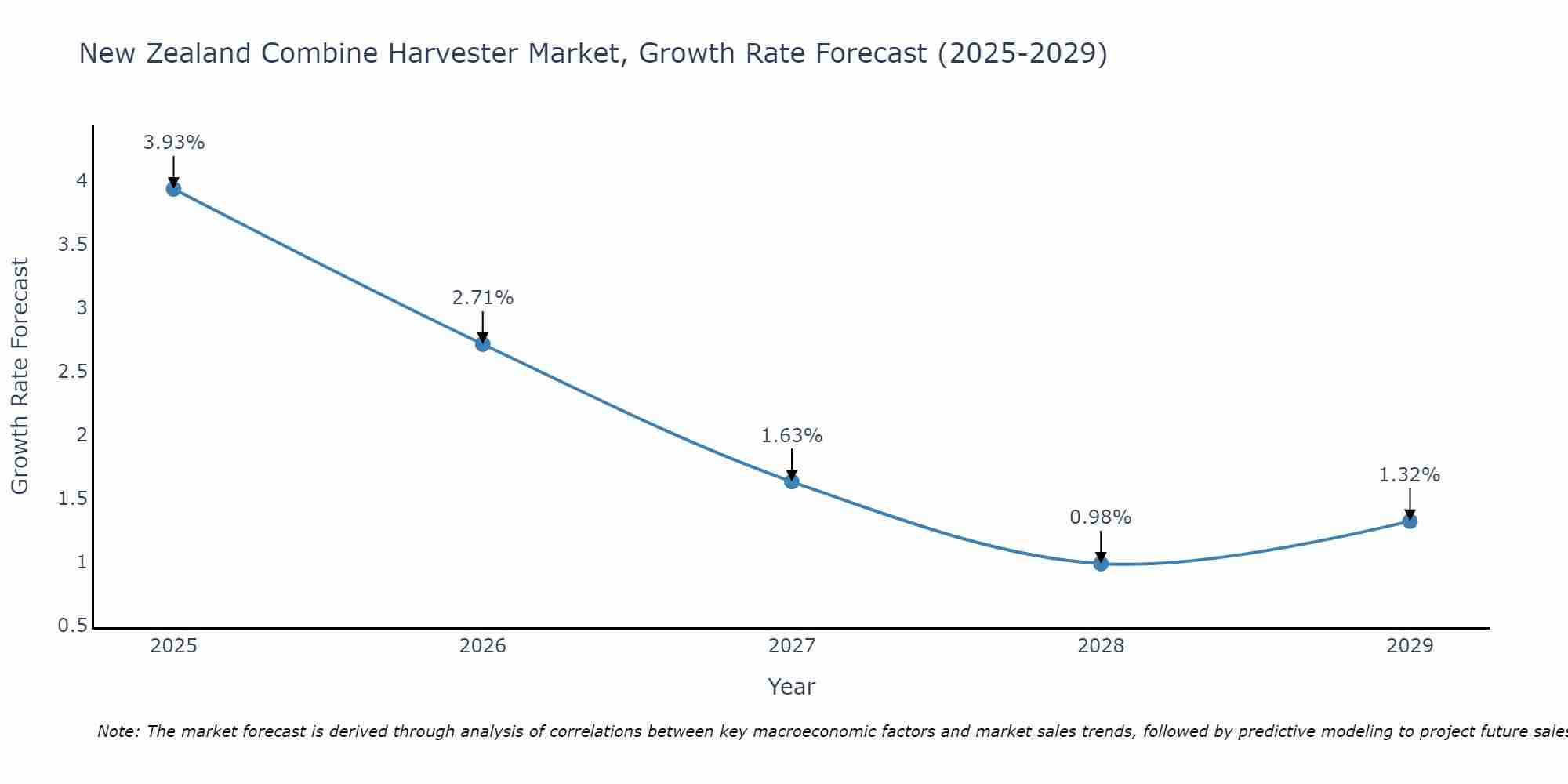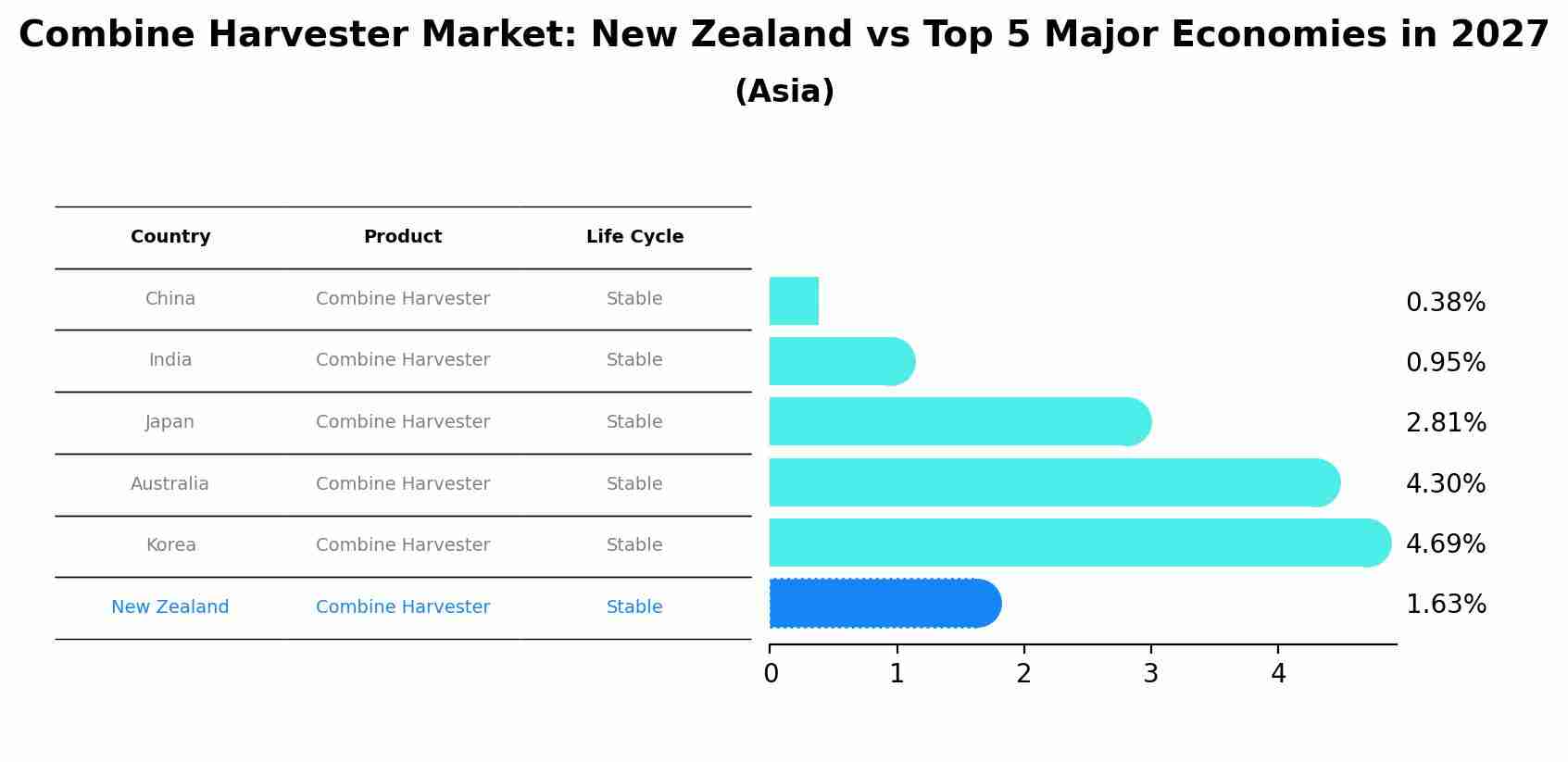New Zealand Combine Harvester Market (2025-2031) | Trends, Revenue, Industry, Segmentation, Growth, Outlook, Share, Size, Value, Analysis, Companies & Forecast
| Product Code: ETC5398282 | Publication Date: Nov 2023 | Updated Date: Aug 2025 | Product Type: Market Research Report | |
| Publisher: 6Wresearch | Author: Bhawna Singh | No. of Pages: 60 | No. of Figures: 30 | No. of Tables: 5 |
New Zealand Combine Harvester Market Size Growth Rate
The New Zealand Combine Harvester Market is projected to witness mixed growth rate patterns during 2025 to 2029. Beginning strongly at 3.93% in 2025, growth softens to 1.32% in 2029.

Combine Harvester Market: New Zealand vs Top 5 Major Economies in 2027 (Asia)
New Zealand's Combine Harvester market is anticipated to experience a stable growth rate of 1.63% by 2027, reflecting trends observed in the largest economy China, followed by India, Japan, Australia and South Korea.

New Zealand Combine Harvester Market Overview
Combine harvesters are essential agricultural machinery used for harvesting grains, cereals, and other crops, improving efficiency and productivity in the field. In New Zealand, the combine harvester market caters to a diverse range of farming operations, including arable cropping, horticulture, and viticulture, with demand influenced by factors such as crop yields, weather conditions, and technological advancements in farm mechanization.
Drivers of the market
The New Zealand Combine Harvester Market is driven by the need for efficient and high-capacity agricultural machinery. The growing agricultural sector, coupled with the adoption of modern farming techniques, increases the demand for combine harvesters. Additionally, government initiatives to support agricultural mechanization boost the market.
Challenges of the market
Dependence on weather conditions for agricultural operations can lead to unpredictable demand fluctuations and inventory management challenges.
Government Policy of the market
Combine harvesters are essential agricultural machinery used for harvesting crops efficiently. In New Zealand, government policies may support sustainable farming practices and agricultural productivity. Regulations may focus on safety standards, emissions control, and incentives for investment in modern harvesting equipment.
Key Highlights of the Report:
- New Zealand Combine Harvester Market Outlook
- Market Size of New Zealand Combine Harvester Market, 2024
- Forecast of New Zealand Combine Harvester Market, 2031
- Historical Data and Forecast of New Zealand Combine Harvester Revenues & Volume for the Period 2021-2031
- New Zealand Combine Harvester Market Trend Evolution
- New Zealand Combine Harvester Market Drivers and Challenges
- New Zealand Combine Harvester Price Trends
- New Zealand Combine Harvester Porter`s Five Forces
- New Zealand Combine Harvester Industry Life Cycle
- Historical Data and Forecast of New Zealand Combine Harvester Market Revenues & Volume By Cutting Width for the Period 2021-2031
- Historical Data and Forecast of New Zealand Combine Harvester Market Revenues & Volume By Small Size Combine Harvester for the Period 2021-2031
- Historical Data and Forecast of New Zealand Combine Harvester Market Revenues & Volume By Large Size Combine Harvester for the Period 2021-2031
- Historical Data and Forecast of New Zealand Combine Harvester Market Revenues & Volume By Type for the Period 2021-2031
- Historical Data and Forecast of New Zealand Combine Harvester Market Revenues & Volume By Wheel Type Combine Harvester for the Period 2021-2031
- Historical Data and Forecast of New Zealand Combine Harvester Market Revenues & Volume By Crawler Type Combine Harvester for the Period 2021-2031
- Historical Data and Forecast of New Zealand Combine Harvester Market Revenues & Volume By Power Source for the Period 2021-2031
- Historical Data and Forecast of New Zealand Combine Harvester Market Revenues & Volume By Tractor Pulled/PTO Powered Combine Harvester for the Period 2021-2031
- Historical Data and Forecast of New Zealand Combine Harvester Market Revenues & Volume By Self-Propelled Combine Harvester for the Period 2021-2031
- New Zealand Combine Harvester Import Export Trade Statistics
- Market Opportunity Assessment By Cutting Width
- Market Opportunity Assessment By Type
- Market Opportunity Assessment By Power Source
- New Zealand Combine Harvester Top Companies Market Share
- New Zealand Combine Harvester Competitive Benchmarking By Technical and Operational Parameters
- New Zealand Combine Harvester Company Profiles
- New Zealand Combine Harvester Key Strategic Recommendations
Frequently Asked Questions About the Market Study (FAQs):
1 Executive Summary |
2 Introduction |
2.1 Key Highlights of the Report |
2.2 Report Description |
2.3 Market Scope & Segmentation |
2.4 Research Methodology |
2.5 Assumptions |
3 New Zealand Combine Harvester Market Overview |
3.1 New Zealand Country Macro Economic Indicators |
3.2 New Zealand Combine Harvester Market Revenues & Volume, 2021 & 2031F |
3.3 New Zealand Combine Harvester Market - Industry Life Cycle |
3.4 New Zealand Combine Harvester Market - Porter's Five Forces |
3.5 New Zealand Combine Harvester Market Revenues & Volume Share, By Cutting Width, 2021 & 2031F |
3.6 New Zealand Combine Harvester Market Revenues & Volume Share, By Type, 2021 & 2031F |
3.7 New Zealand Combine Harvester Market Revenues & Volume Share, By Power Source, 2021 & 2031F |
4 New Zealand Combine Harvester Market Dynamics |
4.1 Impact Analysis |
4.2 Market Drivers |
4.2.1 Increasing demand for agricultural mechanization in New Zealand |
4.2.2 Technological advancements in combine harvester equipment |
4.2.3 Growing focus on enhancing agricultural productivity and efficiency |
4.3 Market Restraints |
4.3.1 High initial investment costs for purchasing combine harvesters |
4.3.2 Dependence on external factors such as weather conditions impacting harvest cycles |
5 New Zealand Combine Harvester Market Trends |
6 New Zealand Combine Harvester Market Segmentations |
6.1 New Zealand Combine Harvester Market, By Cutting Width |
6.1.1 Overview and Analysis |
6.1.2 New Zealand Combine Harvester Market Revenues & Volume, By Small Size Combine Harvester, 2021-2031F |
6.1.3 New Zealand Combine Harvester Market Revenues & Volume, By Large Size Combine Harvester, 2021-2031F |
6.2 New Zealand Combine Harvester Market, By Type |
6.2.1 Overview and Analysis |
6.2.2 New Zealand Combine Harvester Market Revenues & Volume, By Wheel Type Combine Harvester, 2021-2031F |
6.2.3 New Zealand Combine Harvester Market Revenues & Volume, By Crawler Type Combine Harvester, 2021-2031F |
6.3 New Zealand Combine Harvester Market, By Power Source |
6.3.1 Overview and Analysis |
6.3.2 New Zealand Combine Harvester Market Revenues & Volume, By Tractor Pulled/PTO Powered Combine Harvester, 2021-2031F |
6.3.3 New Zealand Combine Harvester Market Revenues & Volume, By Self-Propelled Combine Harvester, 2021-2031F |
7 New Zealand Combine Harvester Market Import-Export Trade Statistics |
7.1 New Zealand Combine Harvester Market Export to Major Countries |
7.2 New Zealand Combine Harvester Market Imports from Major Countries |
8 New Zealand Combine Harvester Market Key Performance Indicators |
8.1 Average utilization rate of combine harvesters in New Zealand |
8.2 Adoption rate of precision agriculture techniques in conjunction with combine harvester usage |
8.3 Efficiency improvement percentage in terms of fuel consumption and crop yield per hectare |
9 New Zealand Combine Harvester Market - Opportunity Assessment |
9.1 New Zealand Combine Harvester Market Opportunity Assessment, By Cutting Width, 2021 & 2031F |
9.2 New Zealand Combine Harvester Market Opportunity Assessment, By Type, 2021 & 2031F |
9.3 New Zealand Combine Harvester Market Opportunity Assessment, By Power Source, 2021 & 2031F |
10 New Zealand Combine Harvester Market - Competitive Landscape |
10.1 New Zealand Combine Harvester Market Revenue Share, By Companies, 2024 |
10.2 New Zealand Combine Harvester Market Competitive Benchmarking, By Operating and Technical Parameters |
11 Company Profiles |
12 Recommendations | 13 Disclaimer |
- Single User License$ 1,995
- Department License$ 2,400
- Site License$ 3,120
- Global License$ 3,795
Search
Thought Leadership and Analyst Meet
Our Clients
Related Reports
- Germany Breakfast Food Market (2026-2032) | Industry, Share, Growth, Size, Companies, Value, Analysis, Revenue, Trends, Forecast & Outlook
- Australia Briquette Market (2025-2031) | Growth, Size, Revenue, Forecast, Analysis, Trends, Value, Share, Industry & Companies
- Vietnam System Integrator Market (2025-2031) | Size, Companies, Analysis, Industry, Value, Forecast, Growth, Trends, Revenue & Share
- ASEAN and Thailand Brain Health Supplements Market (2025-2031) | Strategy, Consumer Insights, Analysis, Investment Trends, Opportunities, Growth, Size, Share, Industry, Revenue, Segments, Value, Segmentation, Supply, Forecast, Restraints, Outlook, Competition, Drivers, Trends, Demand, Pricing Analysis, Competitive, Strategic Insights, Companies, Challenges
- ASEAN Bearings Market (2025-2031) | Strategy, Consumer Insights, Analysis, Investment Trends, Opportunities, Growth, Size, Share, Industry, Revenue, Segments, Value, Segmentation, Supply, Forecast, Restraints, Outlook, Competition, Drivers, Trends, Demand, Pricing Analysis, Competitive, Strategic Insights, Companies, Challenges
- Europe Flooring Market (2025-2031) | Outlook, Share, Industry, Trends, Forecast, Companies, Revenue, Size, Analysis, Growth & Value
- Saudi Arabia Manlift Market (2025-2031) | Outlook, Size, Growth, Trends, Companies, Industry, Revenue, Value, Share, Forecast & Analysis
- Uganda Excavator, Crane, and Wheel Loaders Market (2025-2031) | Strategy, Consumer Insights, Analysis, Investment Trends, Opportunities, Growth, Size, Share, Industry, Revenue, Segments, Value, Segmentation, Supply, Forecast, Restraints, Outlook, Competition, Drivers, Trends, Demand, Pricing Analysis, Competitive, Strategic Insights, Companies, Challenges
- Rwanda Excavator, Crane, and Wheel Loaders Market (2025-2031) | Strategy, Consumer Insights, Analysis, Investment Trends, Opportunities, Growth, Size, Share, Industry, Revenue, Segments, Value, Segmentation, Supply, Forecast, Restraints, Outlook, Competition, Drivers, Trends, Demand, Pricing Analysis, Competitive, Strategic Insights, Companies, Challenges
- Kenya Excavator, Crane, and Wheel Loaders Market (2025-2031) | Strategy, Consumer Insights, Analysis, Investment Trends, Opportunities, Growth, Size, Share, Industry, Revenue, Segments, Value, Segmentation, Supply, Forecast, Restraints, Outlook, Competition, Drivers, Trends, Demand, Pricing Analysis, Competitive, Strategic Insights, Companies, Challenges
Industry Events and Analyst Meet
Whitepaper
- Middle East & Africa Commercial Security Market Click here to view more.
- Middle East & Africa Fire Safety Systems & Equipment Market Click here to view more.
- GCC Drone Market Click here to view more.
- Middle East Lighting Fixture Market Click here to view more.
- GCC Physical & Perimeter Security Market Click here to view more.
6WResearch In News
- Doha a strategic location for EV manufacturing hub: IPA Qatar
- Demand for luxury TVs surging in the GCC, says Samsung
- Empowering Growth: The Thriving Journey of Bangladesh’s Cable Industry
- Demand for luxury TVs surging in the GCC, says Samsung
- Video call with a traditional healer? Once unthinkable, it’s now common in South Africa
- Intelligent Buildings To Smooth GCC’s Path To Net Zero


















